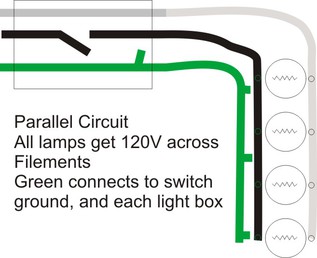Lloyd In South Carolina
Member
Last summer I wired the small Barn/Shed at our new place. Had underground service put it, wired a panel with just basic service, 6 outlets and 5 porcilen light fixtures..... 2 circuits. Not the most complex wiring I've ever done for sure. It all passed inspection and I thought I was good to go.
The driven me nuts part..... Have a light circuit, 5 regular lights (100 watt bulbs) wired in series on 1 light switch. I'm on my 6th light switch,,, yep bought the good ones, and the cheap ones and they last about 6-10 cycles (turning the lights on and off) and the switch is shot. Obviously something wrong with my circuit!!!
#1) I've had all the fixtures apart 3 times, nothing crossed, all is wired correctly.
#2) I've left the lights on all day while I'm there on site, nothing gets hot, it never fails.
#3) Last 3 months I've used the breaker to turn the lights on and off, same switch has lasted many cycles.... of course the switch is staying on,,, not cycling.
All I can think of is I have a bad wire somewhere. At this point thinking I need to rewire the entire cicuit with new wire.
Anybody have any thoughts on how I might eliminate it down to one wire run? They are ran in series, switch to closes light, from that light to the next etc etc..
Signed, Nuts.
The driven me nuts part..... Have a light circuit, 5 regular lights (100 watt bulbs) wired in series on 1 light switch. I'm on my 6th light switch,,, yep bought the good ones, and the cheap ones and they last about 6-10 cycles (turning the lights on and off) and the switch is shot. Obviously something wrong with my circuit!!!
#1) I've had all the fixtures apart 3 times, nothing crossed, all is wired correctly.
#2) I've left the lights on all day while I'm there on site, nothing gets hot, it never fails.
#3) Last 3 months I've used the breaker to turn the lights on and off, same switch has lasted many cycles.... of course the switch is staying on,,, not cycling.
All I can think of is I have a bad wire somewhere. At this point thinking I need to rewire the entire cicuit with new wire.
Anybody have any thoughts on how I might eliminate it down to one wire run? They are ran in series, switch to closes light, from that light to the next etc etc..
Signed, Nuts.


